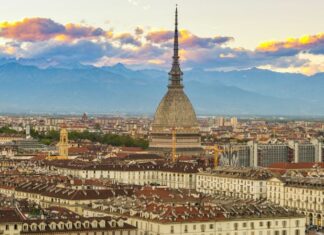Also known as “the Salon” of the city – a typical place for intellectual gathering – Piazza San Carlo was commissioned by Marie Christine of France in true Parisian style with seemingly endless porticoes housing fashion boutiques.
Formerly a parade square and the city’s marketplace, Piazza San Carlo is located along an axis bisected by the highly central via Roma. Considered the most beautiful square in the city, it still preserves the harmonious 17th-century appearance that architect Carlo di Castellamonte gave it when it was originally built.
Spread over an area of 12,768 square meters, it is a rectangle of perfect proportions with an equestrian statue of Duke Emanuele Filiberto of Savoy, affectionately known to locals as the “Caval ed Bronz“(the Bronze Horse) at its centre. The monument shows the 16th-century Italian hero in the act of sheathing his sword after the victory of San Quintino (1557). Overlooking the square to the east is the 17th century Palazzo Solaro del Borgo. Featuring lavishly decorated 18th-century rooms, the Palazzo is now home to the Accademia Filarmonica (Philharmonic Academy). The short, south-westerly side of the square is bordered by the Baroque facades of the twin churches of Santa Cristina and San Carlo.
However, Piazza San Carlo is not as famous for its monumental appearance as it is for the important social role that it has played since it was first built. It is not therefore surprising that it is described as “the Salon of Turin”: it was, and continues to be, a site for concerts, political demonstrations and various social and cultural events, as well as celebrations honouring the Juventus football teams, Turin’s home team.
The square is lined with an array of cafés where intellectuals and men of culture, but also noblemen and members of the royal family, would meet. Among these, standouts include Caffé San Carlo, which opened in 1842 and was one of the favourite haunts of Camillo Benso Count of Cavour; Caffé Torino, which was patronized by writer Cesare Pavese and politician Alcide De Gasperi; and Confetteria Stratta, which still boasts its original 1836 furnishings. Here, in addition to numerous sweet treats, you’ll also find traditional giandujotti, the delicious and most symbolic hazelnut chocolate of Piedmont.




